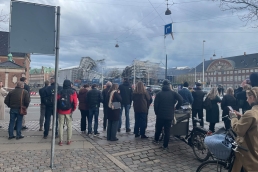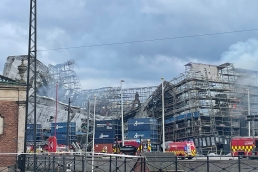The Copenhagen Stock Exchange Fire and Lessons from Notre Dame
On April 16, 2024, at approximately 7:36 AM, a fire broke out at Copenhagen’s iconic Børsen, the former stock exchange building, which was undergoing renovations and surrounded by temporary scaffolding. The fire spread rapidly due to the materials around the site and the complex layout of the scaffolding, making it challenging for firefighters to contain the blaze. This incident had a striking resemblance to a similar tragedy that occurred just a few years prior: the fire at Notre Dame Cathedral in Paris on April 15, 2019. This case study examines the Copenhagen Stock Exchange fire, with insights drawn from the Notre Dame blaze, highlighting the critical importance of fire safety in construction and renovation projects.
Background
Notre Dame Cathedral, a masterpiece of Gothic architecture, is one of the most famous cultural landmarks in the world. The fire that engulfed the cathedral in 2019 during renovation work resulted in extensive damage to its roof, spire, and several important relics. Investigations suggested that the fire was likely sparked by a stray cigarette butt or an electrical short circuit, shedding light on the significant risks inherent in renovation projects. Despite its historical and cultural significance, Notre Dame lacked adequate fire detection and suppression systems, pointing to the crucial need for advanced fire safety measures in heritage sites.
Lessons Learned from Notre Dame
The Notre Dame fire underscored several important lessons for fire safety in renovation and construction sites:
- Up-to-Date Fire Detection Systems: The absence of advanced fire detection and suppression systems can lead to devastating outcomes. Installing wireless fire alarms with smoke and heat detectors, such as the WES3 system, can detect fires in their early stages and trigger immediate responses.
- Stringent Safety Protocols: Construction sites must implement and enforce strict safety protocols, including prohibitions on smoking near flammable materials and thorough inspections of electrical installations. Regular worker training ensures adherence to these measures.
- Rapid Response Planning: Prompt action can contain fires and reduce damage. Clear emergency response plans, with designated evacuation routes and procedures, can save lives and minimise harm to cultural heritage.
- Monitoring and Alerts: Modern technology, including wireless fire alarm systems like WES3, enables real-time monitoring of renovation sites and the prompt dispatch of alerts in the event of fire or other emergencies.
- Public Support and Investment: Notre Dame’s restoration was supported by 850 million euros ($911.29 million) in donations from the general public, France's wealthiest individuals, and public financing. This demonstrates the public's emotional and financial investment in preserving heritage sites.
Importance of Safeguarding Construction Sites
The fire at Copenhagen’s former stock exchange mirrored the incident at Notre Dame in several ways, including the potential causes and the obstacles faced by firefighters. Both incidents highlight the need for comprehensive fire safety measures in renovation projects to protect workers, first responders, and cultural landmarks. Advanced fire safety technologies, stringent protocols, and proactive emergency planning are essential to preventing such tragedies. Additionally, effective measures, such as implementing advanced fire safety technologies like wireless fire alarm systems and establishing clear safety protocols, can mitigate risks. Protecting historic landmarks is not only crucial for preserving cultural heritage but also for ensuring the safety of construction workers and surrounding communities.
Conclusion
The fires at Notre Dame Cathedral and the Copenhagen Stock Exchange serve as sombre reminders of the vital importance of fire safety during construction and renovation projects. By learning from these incidents and implementing state-of-the-art fire detection and suppression systems, we can better protect our cultural heritage and guarantee the safety of workers and first responders. Investing in modern fire safety technology, such as wireless fire alarm systems like WES3 and REACT Emergency Notification System, offers a proactive approach to safeguarding historic landmarks and preventing potential tragedies.

